Q 1 A student heats a beaker containing ice and water. He measures the temperature of the content of the beaker as a function of time. Which of the following (shown in figure given below) would correctly represent the result? Justify your choice.

Ans.
Since ice and water are in equilibrium, the temperature would be zero. When we heat the mixture, energy supplied is utilised in melting the ice and
the temperature does not change till all the ice melts because of latent heat of fusion. On further heating, the temperature of the water would increase. Therefore, the correct option is (d).
Q 2 Explain how the rate of evaporation of a liquid is affected with:
- Increase in temperature of the liquid.
- Decrease in exposed surface area.
- Increase in moisture in the surrounding air.
- Increase in wind speed.
Ans.
- Rate of evaporation increases with rise in temperature.
- Evaporation is less when exposed surface area decreases.
- Less evaporation if moisture content is high in the air.
- Rate of evaporation increases if wind speed increases.
Q 3 You want to wear your favourite shirt to a party, but the problem is that it is still wet after a wash. What steps would you take to dry it faster?
Ans.
Conditions that can increase the rate of evaporation of water are:
- An increase in the surface area by spreading the shirt.
- An increase in the temperature by putting the shirt under the sun.
- Increase in the wind speed by spreading it under the fan.
Q 4 Describe an activity to determine the boiling point of water and melting point of ice.

Ans.
Determination of boiling point of water:
- In a beaker take some water and insert a thermometer in it with the help of a clamp.
- Put the beaker on a tripod stand and heat the apparatus with the help of kerosene burner slowly.
- Observe what happens to water.
- You will observe a steady stream of bubbles. This temperature is the boiling point of water.
Determination of melting point of ice:
- Take crushed ice in a beaker and insert a thermometer in the beaker by hanging it from the clamp of the stand in such a way that the bulb of the thermometer is completely inside the ice.
- Wait for some time and keep recording the temperature after small intervals of time.
- Note down the temperature when ice just starts melting.
- Let the bulb of the thermometer remain in mixture of ice and water for some more time and keep recording the temperature. This temperature is the melting point of ice.
Q 5 While heating ice in a beaker with a thermometer suspended in it, a student recorded the following observations:

Based on the above observations, answer the following questions:
(a) State the change(s) observed between 2-3 min. and name the process involved.
(b) Between 30-35 min., the temperature remains constant. State the reason for this. Name the heat involved in the process and define it.
Ans.
(a) Between 2-3 min, ice converts into water. This process is known as fusion.
(b) Between 30-35 min, the temperature remains constant because the heat supplied is used up in overcoming the intermolecular forces of liquid to change into vapours. The heat involved in the process is latent heat of vaporisation. It is the amount of heat energy required to change 1 kg of liquid into gas at its boiling point.
Q 6 Design an experiment to show that ammonium chloride undergoes sublimation.

Ans.
- Take crystals of ammonium chloride in a china dish.
- Put the china dish on a tripod stand with wire gauze.
- Put an inverted funnel on the china dish and insert a cotton plug in the stem of the funnel.
- Heat the china dish on a low flame.
- In the inside of the funnel white deposits of ammonium chloride is seen which directly converts into gaseous state and then solidifies.
Q 7 Explain interconversion of three states of matter with the help of flow chart. Name the process of each interconversion.
Ans
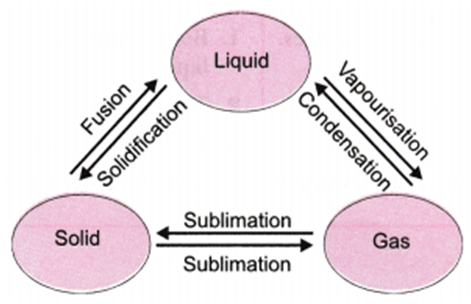
Q 8 Why are xylem and phloem called complex tissues? How are they different from one other ?
Ans.
| Xylem | Phloem |
| 1. Xylem mainly consists of dead cells (except xylem parenchyma). | 1. Phloem consists of living cells (except phloem fibre). |
| 2. It conducts water and minerals from roots to aerial parts of the plant. | 2. It translocates prepared food from leaves to storage organs and growing parts of the body. |
Q 9 Write a short note on xylem.
Ans.
Xylem is complex permanent tissue and is also known as conduction tissues. It consists of tracheids, vessels, xylem parenchyma and xylem fibres. The cells have thick walls, and many of them are dead. Tracheids and vessels are tubular structures. This allows them to transport water and mineral vertically upwards. The parenchyma stores food and helps in the lateral conduction of water. Fibres are mainly supportive in function.
Q 10 Name the different components of xylem and draw a living component.
Ans. Xylem consists of tracheids, vessels, xylem parenchyma and xylem fibres. The only living component of xylem is xylem parenchyma.
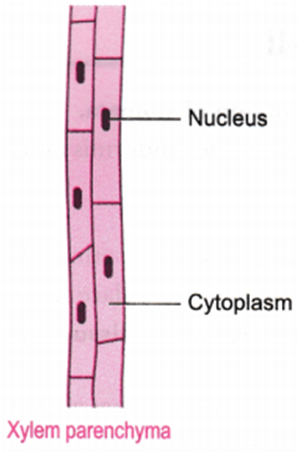
Q 11 Why are plants and animals made of different types of tissue?
Ans.
Plants and animals are two different types of organisms. Plants are autotrophic organisms, so they prepare their own food by photosynthesis. Moreover, plants are stationary or fixed organisms. Since they do not consume or need much energy, so most of the tissues of plants are supportive. Most of these tissues such as xylem, phloem, sclerenchyma and cork are dead tissues, i.e., they do not contain living protoplasm.
Animals on the other hand, are heterotrophic organisms. They have to move in search of food, mate and shelter; so they need more energy as compared to plants. Most of these tissues contain living protoplasm.
There are some tissues in plants which divide throughout life. They divide for the growth and reproduction of the plants. In contrast to plants, growth in animals is uniform.
Q 12 What is a neuron? Write the structure and functions of a neuron.
Ans. Nervous tissue contains highly specialised unit cells called nerve cells or neurons. Each neuron has the following three parts:
- The cyton or cell body: It contains a central nucleus and cytoplasm with characteristic deeply stained particles, called Nissl granules.
- The dendrites: These are short processes arising from the cyton.
- The axon: It is a single, long, cylindrical process of uniform diameter It carries impulses away from the cell body.
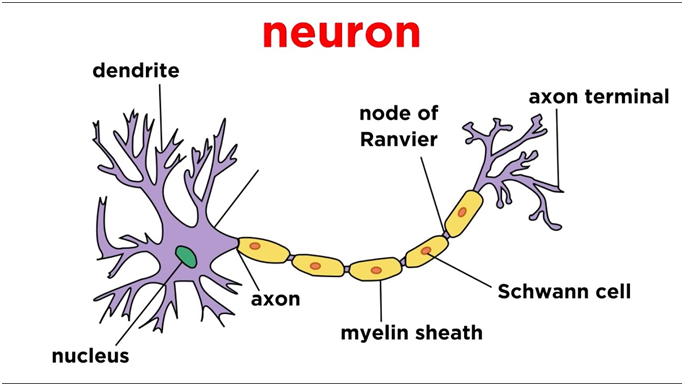
Functions:
Neurons have the ability to receive stimuli from within or outside the body and conduct impulses to different parts of the body. The impulses travel from one neuron to another neuron and finally to the brain or spinal cord.
Q 13 Differentiate between meristematic tissue and permanent tissue.
Ans.
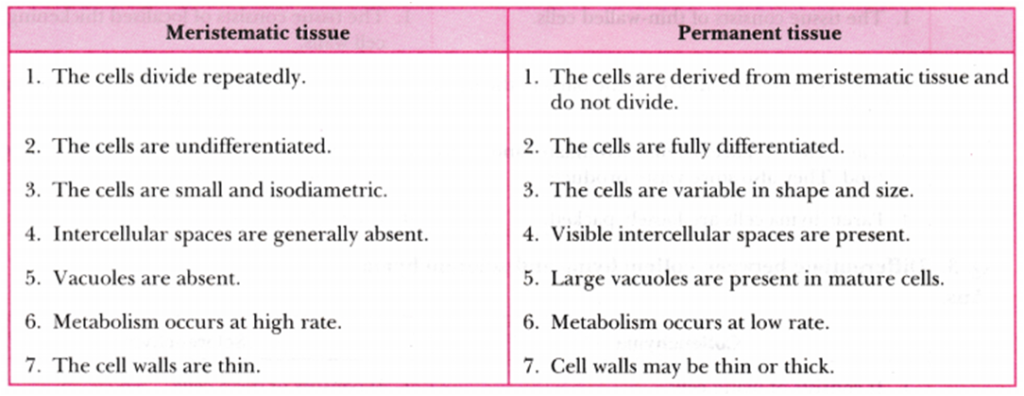
Q 14 Briefly describe striated and smooth muscles with their functions.
Ans. The striated muscle fibres are long or elongated, non-tapering, cylindrical and unbranched. These cells have a number of nuclei called sarcolemma.These muscle fibres shows alternate dark and light stripes or striations and so they are called as striated muscles. These muscles occur in muscles of limbs, body wall, face, neck, etc.
Functions of striated muscles:
- Striated muscles are powerful and undergo rapid contraction and expansion.
- Striated muscles provide the force for locomotion and all other voluntary movements of the body.
The smooth muscles are also known as unstriated or involuntary muscles. Smooth muscles occur as bundles or sheets of elongated fusiform or spindle-shaped cells or fibres. They are held together by loose connective tissue. These muscle fibres are uninucleate and do not bear any bands, stripes or striation across them.
These muscles are found in the walls of the alimentary canal and internal organs, ducts of glands and blood vessels. Smooth muscles are also found in the stomach, intestine, ureters, bronchi, iris of the eye, etc.
Functions of smooth muscles:
- Smooth muscles do not work according to our will, so they are also called involuntary muscles. Movement of food in the alimentary canal or the contraction and relaxation of blood vessels are involuntary movements.
- Smooth muscles contract slowly but can remain contracted for a long period of time. Due to this characteristic, the food passes to the next step of digestion in the alimentary canal.
Q 15 What is a permanent tissue? Classify permanent tissues and describe them.
Ans.
Permanent tissues are derived from meristematic tissue but their cells have lost the power of division and have attained their definite forms.
Permanent tissues are classified into the following two types:
(i) Simple permanent tissue
(ii) Complex permanent tissue
(i) Simple permanent tissues: These tissues are composed of cells which are structurally and
functionally similar.
Simple permanent tissues are further classified into the following three types:
- Parenchyma: Parenchyma forms the bulk of the plant body. Parenchyma cells are living and possess the power of division.
- Collenchyma: Collenchyma tissue is also living. It is characterised by the deposition of extra cellulose at the corners of the cells.
- Sclerenchyma: Sclerenchyma cells are dead cells and they are devoid of protoplasm. The cell walls of sclerenchyma are largely thickened with deposition of lignin.
(ii) Complex permanent tissues: The complex tissues consist of more than one type of cells having a common origin. All these cells coordinate to perform a common function.
Complex tissues are of the following two types:
- Xylem: Xylem is a vascular and mechanical tissue. It is a conducting tissue. Xylem is composed of four different types of cells: (i) Tracheids (ii) Vessels (Hi) Xylem parenchyma (iv) Xylem sclerenchyma.
Except xylem parenchyma, all other xylem elements are dead and bounded by thick lignified walls. - Phloem: Like xylem, phloem is also vascular but has no mechanical function. Phloem is composed of following four elements: (i) Sieve tubes (ii) Companion cells (iii) Phloem parenchyma (iv) Phloem fibres.
Except phloem fibres, all other phloem elements are living.
Xylem and phloem are both conducting tissues and are also known as vascular tissues. Together, both of them constitute vascular bundle.
Q 16 With the help of a graph, derive the relation v = u + at.
Ans.
Consider the velocity-time graph of an object that moves under uniform acceleration as shown in the figure (u ≠ 0).
From this graph, we can see that initial velocity of the object (at point A) is u and then it increases tow (at point B) in time t. The velocity changes at a uniform rate a. As shown in the figure, the lines BC and BE are drawn from point B on the time and the velocity axes respectively, so that the initial velocity is represented by OA, the final velocity is represented by BC and the time interval t is represented by OC. BD = BC – CD, represents the change in velocity in time interval t.

If we draw AD parallel to OC, we observe that
BC = BD + DC = BD + OA
Substituting, BC with v and OA with u,
we get
v = BD + u
or BD = v – u …(1)

Q 16 Differentiate between distance and displacement.
Ans.

Q 17 Suppose a squirrel is moving at a steady speed from the base of a tree towards some nuts. It then stays in the same position for a while, eating the nuts, before returning to the tree at the same speed. A graph can be plotted with distance on the x-axis and the time on y-axis
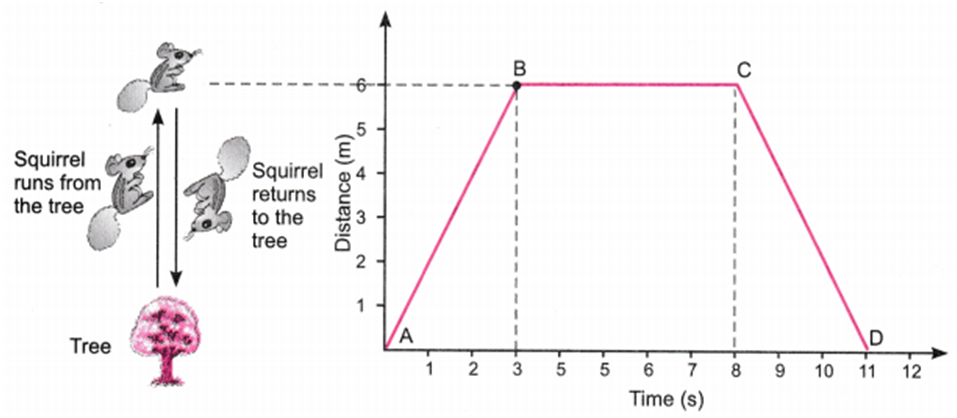
Observe the graph carefully and answer the following questions.
(i) Which part of the graph shows the squirrel moving away from the tree?
(ii) Name the point on the graph which is 6 m away from the base of the tree.
(iii) Which part of the graph shows that the squirrel is not moving?
(iv) Which part of the graph shows that the squirrel is returning to the tree?
(v) Calculate the speed of the squirrel from the graph during its journey.
Ans.
(i) Part AB
(ii) Part B
(iii) Part BC
(iv) Part CD
(v) Total distance travelled = 6m + 6m=12m
Time = 11 s.

Q 18 With the help of a graph, derive the relation v = u + at.
Ans.
Consider the velocity-time graph of an object that moves under uniform acceleration as shown in the figure (u ≠ 0).
From this graph, we can see that initial velocity of the object (at point A) is u and then it increases tow (at point B) in time t. The velocity changes at a uniform rate a. As shown in the figure, the lines BC and BE are drawn from point B on the time and the velocity axes respectively, so that the
The data regarding the motion of two different objects P and Q is given in the following table. Examine them carefully and state whether the motion of the objects is uniform or non-uniform.

Ans.
We can see that the object P covers a distance of 10 m in every fifteen minutes. In other words, it covers equal distance in equal interval of time. So, the motion of object P is uniform. On the other hand, the object Q covers 7 m from 9:30 am to 9:45 am, 4 m from 9:45 am to 10:00 am, and so on. In other words, it covers unequal distance in equal interval of time. So, the motion of object Q is non-uniform.
Q 19 What is the difference between uniform velocity and non-uniform velocity?
Ans. Uniform velocity: An object with uniform velocity covers equal distances in equal intervals of time in a specified direction, e.g., an object moving with speed of 40 kmh-1 towards west has uniform velocity.
Non-uniform velocity: When an object covers unequal distances in equal intervals of time in a specified direction, or if the direction of motion changes, it is said to be moving with a non-uniform or variable velocity, e.g., revolving fan at a constant speed has variable velocity.
Q 20 Given below is the velocity-time graph for the motion of the car. What does the nature of the graph show ? Also find the acceleration of the car.
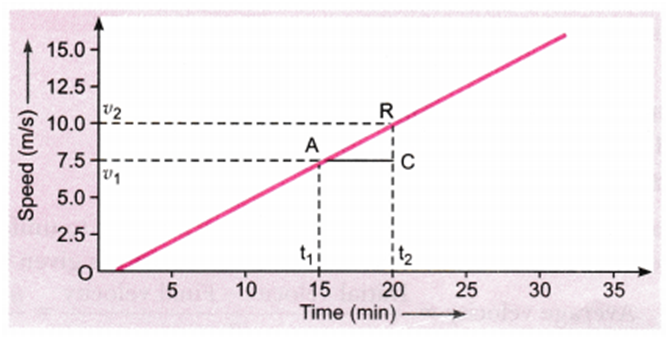
Ans. The nature of the graph shows that velocity changes by equal amounts in equal intervals of time. For a uniformly accelerated motion, velocity-time graph is always a straight line.
As we know, acceleration is equal to the slope of the graph
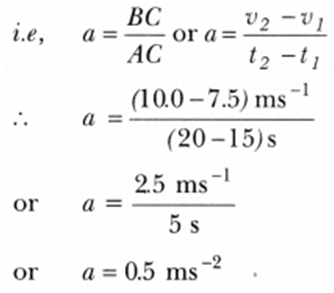
Q 21 A body is thrown vertically upward with velocity u, the greatest height h to which it will rise is,
(a) ulg
(b) u2l2g
(c) u2lg
(d) ul2g
Ans. (b) u2l2g
Q 22 In which of the following cases of motions, the distance moved and the magnitude of displacement are equal?
(a) If the car is moving on a straight road
(b) If the car is moving in Circular path
(c) The pendulum is moving to and fro
(d) The earth is revolving around the sun.
Ans. (a) If the car is moving on a straight road
Q 23 Seema visited a Natural Gas Compressing unit and found that the gas can be liquefied under specific conditions of temperature and pressure. While sharing her experience with friends she got confused. Help her to identify the correct set of conditions.
(a) Low temperature, low pressure
(b) High temperature, low pressure
(c) Low temperature, high pressure
(d) High temperature, high pressure
Ans. (c) Low temperature, high pressure
Q 24 On converting 25°C, 38°C and 66°C to Kevlin scale, the correct sequence of temperature will be
(a) 298 K, 311 K and 339 K
(b) 298 K, 300 K and 338 K
(c) 273 K, 278 K and 543 K
(d) 298 K, 310 K and 338 K
Ans. (a) 298 K, 311 K and 339 K
Q 25 Select the incorrect sentence.
(a) Blood has a matrix containing proteins, salts and hormones
(b) Two bones are connected by ligament
(c) Tendons are non-fibrous tissue and fragile
(d) Cartilage is a form of connective tissue
Ans. (c) Tendons are non-fibrous tissue and fragile